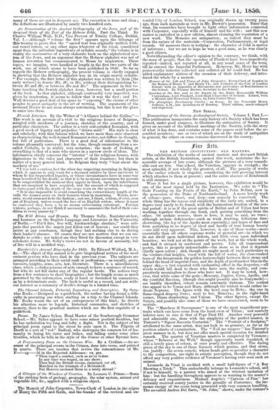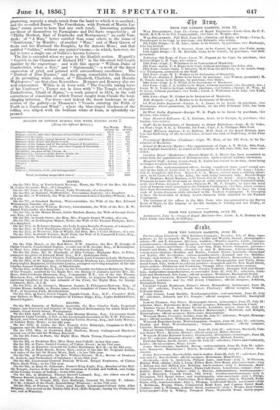irt5.
THE BRITISH INSTITUTION: OLD MASTERS.
The exhibition of the works of ancient masters and deceased British artists, at the British Institution, opened this week, maintains the ho- nourable average of late years, although the pictures of a very remark- able cast are few. One school, the Venetian, appears in strength ; the most splendid, if not wholly the greatest, of all. The paucity of works of the earlier schools is singular, considering the still growing interest which attaches to them at present ; and the entire absence of Rembrandt is still stranger. Were it but for a single picture, however, this exhibition would be one of the most signal held by the Institution. We refer to " The Gods Feasting on the Fruits of the Earth," by John Bellini, now in the possession of the Duke of Northumberland. A more lovely work of colour—pure sweet, and deep—can scarcely be conceived. The whole thing has lhe repose and simplicity of the early art, united, in a degree very rarely to be found, with the harmonious freedom of the cen- tral period : it is as if the great spirits of Bellini and of Titian had been working together through one hand, each gaining something from the other. Of archaic manner, there is here, it may be said, no trace ; although archaic deficiencies—such as weak drawing, fallacious fore- shortening, (the leg of the Apollo most especially,) and types of face and form partaking in no degree of ideal and hardly of true human beauty —are still very apparent. This, however, is one of those works—more essentially than all others supreme works of pictorial art—in which we do not dwell upon individual defects, and little even upon individual beauties ; we look not at the points of the work, but at the whole work, and find it steeped in sentiment and poetry. Like all transcendent poetry, this is properly indescribable—the more so in that it depends chiefly upon colour ; and, though we might speak of such particulars as the verdure-clad heights, vocal with the fall of water, the close-ranked trees of the foreground, the golden horizon-light between their stems and behind the head of imperial Juno, and the depth of profoundest blue in the upper sky,—a tint repeated with enchanting effect in the draperies,—all words would fall dead to those who have seen the reality, and com- paratively meaningless to those who have not. It may be noted, how- ever, that while some of the gods—Mercury, Jupiter, Ceres, Apollo, and the youthful Bacchus, (though this might possibly also be Ganymede)— are readily identified, others remain extremely dubious. The central two appear to be Venus and Mars, although the trident would rather in- dicate Neptune. The figure with the bowl may be Hebe the one in
flame-tinged drapery Juno ; next the to her, Minerva ; in e right-hand corner, Diana slumbering, and Vulcan. The other figures, except the Satyrs, and possibly also some of those we have enumerated, seem to be mortals.
The "Marchese di Savorgnano" is one of the most magnificent por- traits which can have come from the hand even of Titian ; and scarcely inferior save in size is that of Pope Paul III. Another very powerful and admirable one, done with the simplicity of the perfect master, is Tintoret's " Signor Zaccaria Contaxini." The " Portrait of a Sculptor," attributed to the same artist, does not look to us genuine, as far as its position admits of examination. The " Noli me tangere " has Tintoret's great manner in it, but does not offer much special occasion for detailed remark. The quartet of Venetian masters is completed by Veronese; whose "Rebecca at the Well," though apparently much repainted, is still a lovely piece of colour, at once pearly and effective. The daring green of the sky is one of those licences which genius, and that alone, can justify : the seven camels, whose heads give so eculiar a character to the composition, are right in artistic perception, though they do not afford any very positive evidence of Veronese's having ever seen such an animal.
Leonardo (la Vinci is credited with a small half-figure of " A Boy Showing a Trick."' This undoubtedly belongs to Leonardo's school, and if not to himself, to a painter who aimed at the strictest imitation of him : but the handling throughout appears to us wanting in the master's delicacy and exquisiteness. Michael Angelo's " Cartoon of Pisa" has certainly received scanty justice in the grmaille of Pontormo ; the im- mense energy of the scene being presented with very common handling. The so-called Andrea Del Sarto, " St. John," shows, under the restorer's
plastering, scarcely a single touch from the hand to which it is ascribed; , and the so-called Durer, "The Crucifixion, with Portrait of Martin Lu- ther," seems never to have had any such touch. Interesting portraits are those of themselves by Parmigiano and Del Sarto respectively ; of " Philip Herbert., Earl of Pembroke and Montgomery,' an early Van- dyck ; of "A Man," better entitled than some others to the name of "Gentleman," by Murillo ; of another "Man," and of Mary Queen of Scots and her Husband the Dauphin, by Sir Antonio More ; and that entitled " Galileo," without any painter's name —in which, however, we fail to trace a single one of Galileo's known features.
The list is extended when we pass to the English section. Hogarth's " Garrick in the Character of Richard III" is the life-sized full-length familiar by the engravings : and with this appear " William Duke of Cumberland, when a Boy," and " Sigismunda,"—a work of the finest expression of grief; and painted with extraordinary excellence. The " Portrait of Miss Hunter," and the group, remarkable for the richness of its prevailing white colour, of " Elizabeth, Charlotte, and Horatio Waldegravc," arc first-clans Reynoldses. Hoppner and Romney also are well represented. Wilkie is in force with The Guerilla taking leave of his Confessor" • Turner not in force with" The Temple of Jupiter Panhellenius, Island of .gins,"—a work painted in 1814, in the cold correctness of classicism of which Turner caught from Claude the long- clinging infection. Far finer—and indeed the finest landscape in any section of the gallery—is Thomson's " Vessels entering the Frith of Forth in a North-east Wind" ; where the blue-tinged blackness of the rolling sea, ridged with the brilliant white of foam, is splendidly ex- pressed.



























 Previous page
Previous page